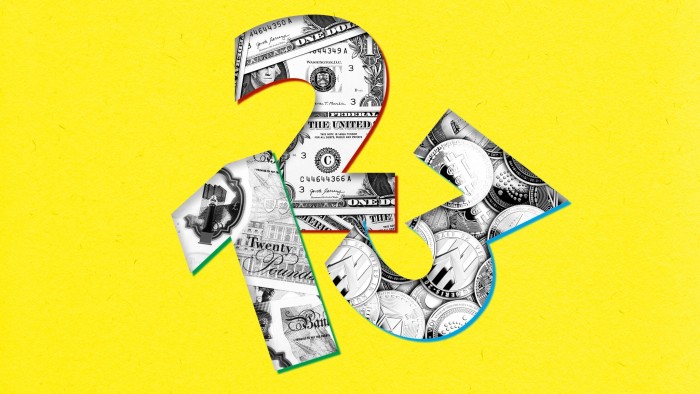Simple rules for managing your money


Roula Khalaf, Editor of the FT, selects her favourite stories in this weekly newsletter.
“What is the one thing I need to know about managing my money?”
This is the question put to me recently by a 23-year-old female friend. Having secured her first “proper” job, she was renting a room in a house share but dreamt of having a shower, fridge and sofa for her sole use.
She searched for money advice online. But the more tips and tricks she read, the more bewildered she became about what to prioritise.
My answer was simple: “Make sure you never run out of money”.
This is what I lived in fear of in my early twenties when I started working full-time as a journalist. My initial attempt at managing money was to not manage it — for a spell, I didn’t open my bank statements and said a silent prayer every time I put my card in a cashpoint.
As a student, I had become used to having a large, interest-free overdraft. My financial epiphany arrived with the letter saying that I had to pay this back or be charged for using it.
That demand prompted me to develop my own “system” for managing my finances properly — and it is one that I have kept to and adapted ever since.
When the money starts to roll in, you must give every pound a purpose. This is a slightly less parental way of saying “set a budget” or “live within your means” but essentially means the same thing. It sounds simple, but plenty of young people struggle with this. A recent study of 15-18-year-old students in the UK found 77 per cent wished they received budgeting lessons at school.
Take an A4 piece of paper, and fold it into four segments. Write your monthly income after tax at the top — then note down how it is being divided between the following four areas:
Start by listing your monthly fixed costs. These are items you have to pay no matter what, like rent, bills, taxes, travel to work and any direct debits on your account. The total of this segment determines what you have left for the others.
Next, your variable costs — clothes, food shopping, coffees, going out (essentially, anything fun — but don’t panic, I am not going to say you have to cut all of these out).
In the third segment, list any debts, the monthly repayments you are making towards these, and the interest rate you are being charged. Do not count student loans as they are essentially a graduate tax and will already have been deducted from your net pay.
The final segment is for savings: what you have got, any goals you are saving towards, like a holiday, and what you are managing to stash away towards these each month (even if it is zero).
This will help you to see how your monthly pay is being divided between the four pots, and how you could do a better job of rebalancing these to reduce your debts and ensure something, however small, is being saved.
The easiest fat to trim from your fixed costs will be the direct debits. Do you really use all the services you subscribe to? After this, it becomes a bit harder. You could switch to a Sim-only deal on your phone, cycle to work or rent a cheaper room. But be realistic.
The variable costs are the ones most likely to blow the budget, inflate the debt segment and deplete your savings — unless you keep them in check. This is something that will dog you, no matter how much you earn in future. Check out website Refinery29’s famous Money Diaries if you don’t believe me.
Your own spending data will reveal your weaknesses. Online shopping is still one of mine. I have a set amount in my monthly budget that I allow myself to spend, but it is constantly being tested by the powerful psychological tricks retailers use. Think sales promotions, discount codes and the rising popularity of “buy now, pay later” services, which are proven to get shoppers spending more.
Spending money that you do not have is an expensive business. For whatever you have seen that takes your fancy, ask yourself if you would still want it if the price was 20 per cent or 40 per cent higher. Why? This is what you will pay in annual interest on your credit card or overdraft if you have to borrow the money to buy it. Another trick is to leave the item in your basket for three days — by which time, your desire to own a pair of pink sequinned Converse may have passed.
Gift buying is an area that many women I know have trouble with, but the quality of a friendship should not be measured by your financial generosity. Socialising is a similarly tricky area, especially if you have friends with more cash to flash than you do. As a doctorate student, my stepdaughter tackled eating out with her higher-earning friends by having a starter as a main course and only drinking water. This is easier to do if you have an ally in your group who is also on a tight budget.
As a student, my approach was rather different. My friend Tina and I would go out clubbing dressed as superheroes clutching “guns” that were water pistols filled with vodka.
You can find your own ways of making savings but the key is setting monthly targets for the four areas on a fresh sheet of A4 paper and reviewing your progress regularly. If you spend more in one area, cut back elsewhere rather than go into debt.
My top tip is to pay your “spending money” into a separate digital bank account and only carry this card around with you. Most banking apps have budgeting tools that allow you to set targets and automatically log different categories of spending, and will alert you when you are running low.
If you have interest-bearing debts, allocating more of your monthly budget to pay these down faster is going to save you money in the long term. Prioritise the ones costing you the most interest. Understanding your spending patterns and building up some savings as a “buffer” should, hopefully, prevent the debt segment from expanding.
I view my savings as part of my fixed costs: it is money that is siphoned off every month, on the day I get paid, no matter what.
It is harder to do this if you are a freelancer with irregular earnings, but even more vital.
Freelancers need to get in the habit of putting money aside for future tax bills, so use an online tax calculator to help you plan. You also need to put time aside for chasing payments. The bane of every freelancer’s life is the gap between doing the work, and being paid for it.
This is why I would advise everyone, but freelancers especially, to build a savings buffer equivalent to at least one or two months of your fixed costs. Remember to replenish this fund after you have borrowed from it.
Any surplus you generate after that can be put to work in longer-term savings and investments, such as pensions and stocks and shares Isas, but learning how to balance your budget is the first step on the journey towards these goals — and my friend’s solo enjoyment of her own shower, fridge and sofa.
Claer Barrett is the editor of FT Money, and a financial commentator on Eddie Mair’s LBC drive-time show, on weekdays between 4-6pm
Email Claer at claer.barrett@ft.com; follow her on Twitter @Claerb and Instagram @Claerb
Comments